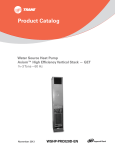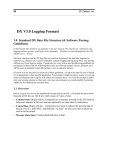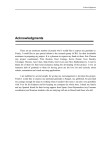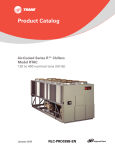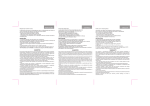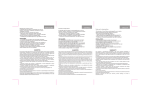Download Trane H-V WSHP .5 to 25 Tons Catalogue
Transcript
Product Catalog Hose Kit Accessories Automatic and Manual Balancing Kits January 2015 WSHP-PRC025D-EN Introduction Choosing the best flow control balancing device for water-source heat pump equipment just got easier. Superior circuit balancing of the HVAC equipment is an important aspect to the overall layout and design of the HVAC system. Proper balance of the system can protect the HVAC equipment, while providing a longer equipment life. Superior circuit balancing can save energy by supplying the proper amount of fluid to make your system perform at its highest efficiency. Trane’s flow balancing choices have taken the guess work out of system balancing. From the most economical means of system balancing, to an automated flow system,Trane’s flow kits support a variety of water-source heat pump applications. The three hose kit choices used in HVAC systems today include: • Manual Hose Kit with a ball valve • Manual Hose Kit with a circuit setter • Automatic, Self-balancing Flow Hose Kit With flow velocities ranging from 0.5 to 60.0 gpm, our automatic balancing device supports a variety of water-source heat pump applications and equipment sizes. It is typically the ideal choice in system balancing, but up-front expense associated to auto flow balancing often deters owners into a manual balancing system. With automatic flow balancing, the actual money spent on the automatic flow kits, can be quickly made up when the tedious work of balancing, and re-balancing the system is recouped by the installing contractor. And in the event that a new piece of equipment is added to the system, or equipment servicing is required, re-balancing of the entire system is necessary. Overall accuracy in the balancing of water flow to the equipment may also be in question when using the manual balancing method. Especially in applications where varying cooling requirements may offer a substantial energy savings to the owner. In this application, manual balancing to support varying pump speeds is not practical. Automatic flow kits are an excellent choice in providing protection through a constant, accurate flow to the equipment. Regardless of your balancing choice and need,Trane suggests several alternatives. All hose kits are model number configured to better support a range of decisions made in any given application. Quality components are an important aspect to installing a fail-proof system. Our hose kits are tested at the manufacturing site to help ensure leaks are non-existent. All flow kits are outfitted with a braided, stainless steel hose on both the supply and the return side of the system.The available hose length options are 18-, 24-, and 36-inches. Optional components, such as aY-ball strainer, sustain systems using brackish or hard water. A 2position isolation valve may be specified in the hose kit design for systems supplying variable water volume control. For questions in entire system balancing for overall life cycle savings,Trane has the answer. Copyright This document and the information in it are the property ofTrane, and may not be used or reproduced in whole or in part without written permission.Trane reserves the right to revise this publication at any time, and to make changes to its content without obligation to notify any person of such revision or change. Trademarks All trademarks referenced in this document are the trademarks of their respective owners. © 2015Trane All rights reserved WSHP-PRC025D-EN Introduction Revision History WSHP-PRC025D-EN (02 January 2015) • WSHP-PRC025D-EN Removed with ATC in Table 5, p. 11 3 Table of Contents Introduction . . . . . . . . . . . . . . . . . . . . . . . . . . . . . . . . . . . . . . . . . . . . . . . . . . . . . . 2 Model Number Description . . . . . . . . . . . . . . . . . . . . . . . . . . . . . . . . . . . . . . . . . . 5 Features and Benefits . . . . . . . . . . . . . . . . . . . . . . . . . . . . . . . . . . . . . . . . . . . . . . 6 Manual Flow Control . . . . . . . . . . . . . . . . . . . . . . . . . . . . . . . . . . . . . . . . . . . . . 6 Circuit Setter Flow Control . . . . . . . . . . . . . . . . . . . . . . . . . . . . . . . . . . . . . . . . 7 Automatic Flow Control . . . . . . . . . . . . . . . . . . . . . . . . . . . . . . . . . . . . . . . . . . 8 Self-Balancing Hose Kits . . . . . . . . . . . . . . . . . . . . . . . . . . . . . . . . . . . . . . . . . 11 Hose Kit Specifications . . . . . . . . . . . . . . . . . . . . . . . . . . . . . . . . . . . . . . . . 12 4 WSHP-PRC025D-EN Model Number Description 3 1 2 3 4 1 * G P M N 0 R 1 2 3 4 5 6 7 8 9 10 11 12 13 Identifying and balancing a system is simple throughTrane’s configurable hose kit model number. Specific selections include: Digit 1: Hose Kit Type 4 = Standard Hose Kit 6 = Y-Body Hose Kit 3 = Standard Hose Kit with Isolation Valve 5 = Y-Body Hose Kit with Isolation Valve 7 = Standard Hose Kit with Isolation Valve (manual balancing) 8 = Standard Hose Kit (manual balancing) Digit 2: Hose Kit Diameter 0= 1= 2= 3= 4= 5= 1/2" Diameter Hose 3/4" Diameter Hose 1" Diameter Hose 1-1/4" Diameter Hose 1-1/2" Diameter Hose 2" Diameter Hose Digit 3: Hose Length 1 = 18" Stainless Steel Hose 2 = 24" Stainless Steel Hose 3 = 36" Stainless Steel Hose Digit 4: Strainer Option 0 = No Strainer 3 = Strainer with Blow-Down Valve and Hose Connector Digit 5: Supply Ball Valve 4 = Supply Ball Valve with Pressure Temperature Port Digit 7-10: Flow Control Digit 12: Reducer Option A.AA = Ball Valve Hose Kit 0.00 Manual Flow Controls 0.50 GPM 1.00 GPM 1.50 GPM 2.00 GPM 2.50 GPM 3.00 GPM 3.50 GPM 4.00 GPM 4.50 GPM 5.00 GPM 6.00 GPM 7.00 GPM 8.00 GPM 9.00 GPM 10.0 GPM 12.0 GPM 14.0 GPM 16.0 GPM 18.0 GPM 20.0 GPM 25.0 GPM 30.0 GPM 35.0 GPM 40.0 GPM 45.0 GPM 50.0 GPM 55.0 GPM 60.0 GPM 0 = No Reducer R = Reducer to Decrease One Size Digit 13: Isolation Valve Option 0 = No Isolation Valve R = Isolation Valve Digit 14-15: Manual Flow Control 00 = Auto flow control AA = 0.23 Cv (1/2” hose) BA = 0.46 Cv (1/2” hose) CA = 0.55 Cv (3/4” hose) DA = 0.87 Cv (1/2” hose) EA = 1.1 Cv (3/4” hose) FA = 1.8 Cv (1/2” hose) GA = 2.2 Cv (3/4” hose) HA = 2.3 Cv (1” hose) JA = 3.3 Cv (1/2” hose) KA = 4 Cv (3/4” hose) LA = 5.4 Cv (1/2” hose) MA = 5.4 Cv (1” hose) NA = 5.5 Cv (1-1/4” hose) PA = 6.7 Cv (3/4” hose) RA = 9.2 Cv (1” hose) SA = 9.8 Cv (1-1/4” hose) TA = 13 Cv (2” hose) UA = 14 Cv (1-1/2” hose) VA = 19 Cv (1-1/2” hose) WA = 20 Cv (1” hose) XA = 20 Cv (1-1/4” hose) YA = 24 Cv (1-1/4” hose) ZA = 34 Cv (2” hose) ZP = 56 Cv (2” hose) Digit 6: Return Ball Valve 1 = Return Ball Valve (no options) 4 = Return Ball Valve with Pressure Temperature Port Digit 11: Memory Stop Option for Manual A.AA Hose Kit N = No Memory Stop 7 = Memory Stop (for ball valve hose kit) 8 = Memory Stop (for manual circuit setter) PT FLOW YBall Strainer with Blow Down Valve and Hose Connector Standard Valve 1/2” to 1 1/4” Dia. Stainless Steel Supply/Return Hoses Ball Valve with P/T Port Y-Body Valve 1/2” to 1 1/4” Dia. Return Ball Valve No P/T Port Isolation Valve Standard Valve 1-1/2” to 2” Dia. Step-Down Reducer Automatic Balancing Flow Control Valves WSHP-PRC025D-EN 5 Features and Benefits Manual Flow Control Ball Valve Flow Control Traditionally, the first choice in a balancing device on a water-source heat pump application is the lowest first cost option. In water-source heat pump fluid flow balancing, this typically employs a manual balancing (ball valve) device with hoses.This method utilizes pressure/temperature (P/T) measurement ports on the ball valves at the entering and leaving side of the heat pump so that pressures and temperatures can be measured within the water piping. A ball valve is then manually throttled to change the amount of flow to the unit to reach the desired temperature or pressure differential. Advantages • Low first cost • Direct access to the water-loop through P/T port for future trouble shooting • Temperature and pressure measurements can cross check balancing • Better water temperature measurement than external sensors Disadvantages • Flow accuracy of ±25% • Each unit must be balanced multiple times because of changing system conditions in balancing other units • Integral differential temperature balancing is less accurate than differential pressure balancing • Pressure drop of hose and fittings must be accounted for in differential pressure measurements Optional Isolation Valve 2-Position Valve ISOLATION VALVE Mesurmeter w/PT’s Ball Valve Flex Hose UNIT RETURN SUPPLY FLOW PT Optional Yball Strainer w/Blowdown Valve & Hose Connector Ball valve flow control hose kit is equipped with: (2) Stainless Steel braided hoses with brass end fittings containing fiber washers. (2) Bronze manual valves with brass ball with option P/T port on return side. 6 WSHP-PRC025D-EN Features and Benefits (1) Optional electronic isolation valve for variable water volume control. (1) OptionalY-ball strainer with brass cap and stainless steel mesh screen (includes blow down valve and hose connector). Table 1. Ball valve Cv factors 1/2" 3/4" 1" 90-Degree (open) 15 30 43 48 80-Degree 9.3 17 28 54 70-Degree 5.0 9.0 16 31 60-Degree 2.9 5.1 9.2 20 50-Degree 1.8 2.9 5.8 12 40-Degree 1.0 1.5 3.1 6.3 30-Degree 0.4 0.7 1.6 3.2 20-Degree 0.1 0.1 0.4 0.8 10-Degree 0 0 0 0 0-Degree (closed) 0 0 0 0 Table 2. 1 1/4" Strainer Cv factors Strainer Size Cv 1/2” 5.1 3/4” 15 1” 27 1-1/4” 50 Note: Pressure drop information can be derived from the formula below: DP: = Q2 Sp Cv2 Q = flow in GPM Sp = specific gravity DP = pressure drop in PSI Cv = flow coefficient Circuit Setter Flow Control Another choice in manual fluid flow balancing of a water-source heat pump includes a Hays Measurmeter circuit setter flow control option.This manual balancing method uses an in-line flow measurement device and an adjustment feature to measure and set flow rates at each heat pump. Advantages • In-line flow measurement device • Easier to use than traditional or differential pressure/differential temperature methods Disadvantages • Flow accuracy of ±20% • Higher pressure drop of circuit setters result in additional pumping energy costs (a 3/4-inch circuit setter with 8-GPM flowing has 15-feet of pressure drop) • Direct readout of flow rate is not possible with a circuit setter • Each unit must be balanced multiple times because of changing system conditions in balancing other equipment Circuit Setter flow control hose kit is equipped with: (2) Stainless Steel braided hoses with brass end fittings containing fiber washers. (1) Bronze manual valve (supply) with brass ball with option P/T port on return side. WSHP-PRC025D-EN 7 Features and Benefits (1) Bronze manual valve includes memory stop positive shut-off and dual P/T ports. (1) Optional electronic isolation valve for variable water volume control. (1) OptionalY-ball strainer with brass cap and stainless steel mesh screen (includes blow down valve and hose connector). Optional Isolation Valve 2-Position Valve ISOLATION VALVE Mesurmeter w/PT’s Ball Valve UNIT RETURN Flex Hose SUPPLY FLOW PT Optional Yball Strainer w/Blowdown Valve & Hose Connector Size 1/2” Cv Value MinMax GPM* 0.23 0.2-0.5 0.46 0.3-1.0 Qty Size 3/4” MinCv Max Value GPM* Qty Cv Min-Max Size Value GPM* Qty 0.55 0.4-1.2 2.3 1.6-5.1 1.1 0.8-2.5 1” 5.4 3.8-12.1 0.87 0.6-1.9 2.2 1.6-4.9 9.2 6.5-20.6 1.8 1.3-4.0 4.0 2.8-8.9 20 14.1-44.7 3.3 2.3-7.4 6.7 4.7-15 5.4 3.8-12.1 Size Cv Value Min-Max GPM* 1-1¼” 5.5 3.9-12.3 Qty Size Cv Value MinMax GPM* 1-½” 14 9.9-31.3 Qty Cv Min-Max Size Value GPM* 2” 13 Qty 9.2-29.1 9.8 6.9-21.9 19 13.4-42.5 34 24.0-76.0 20 14.1-44.7 14 31.1-98.4 56 39.6-125.2 24 17.0-53.7 Automatic Flow Control1 Automatic (Self) Balancing Flow Control For automatic balancing of a water-source heat pump, the Hays™ self-balancing hose kit provides a constant flow rate over the pressure differential range of 2 to 80 psid2. As system pressures 1 For the latest Hayes Fluid Controls specification, please view the latest specification here: http://flowcontrolvalves.haysfluidcontrols.com/category/automatic-balancing-valves 2 At low differential pressure the flow area required to achieve higher flow can exceed the flow area available for the respective series. Therefore, the minimum pressure differential requirement is increased for the higher flow ranges of each series Mesurflo valve. 8 WSHP-PRC025D-EN Features and Benefits change (through further addition of heat pumps, for example) each individual flow control valve will automatically adjust to the new system conditions. In variable water volume applications, there can be large variations in the system water pressure. These pressure changes can adversely affect the system balance and heat pump operation. A self balancing hose kit can provide continuous balancing in this application because of its ability to automatically adjust to the varying system conditions. Advantages • Flow accuracy of ±10% • Broader application in variable water volume pumping systems • Greater flow accuracy results in operation closest to design, with least tenant complaints • Only one pressure differential range of 2 to 80 psid1 • Labor savings during balancing can offset increased material cost • Same or less cost as manual balancing hose kits on smaller diameter hose kits Disadvantages • Greater first cost over other manual balancing methods Automatic flow control hose kit is equipped with: • Stainless Steel braided hoses with brass end fittings containing fiber washers • Bronze manual shut-off valves with brass ball with P/T port on supply side • Brass self-balancing valve • Optional electronic isolation valve for variable water volume control • BronzeY-ball strainer with brass cap and stainless steel mesh screen (includes a blow down valve and hose connector). Optional Isolation Valve 2-Position Valve ISOLATION VALVE 2510 Mesurflo w/PT’s Ball Valve RETURN UNIT Flex Hose SUPPLY FLOW PT Optional Yball Strainer w/Blowdown Valve & Hose Connector 1 WSHP-PRC025D-EN At low differential pressure the flow area required to achieve higher flow can exceed the flow area available for the respective series. Therefore, the minimum pressure differential requirement is increased for the higher flow ranges of each series Mesurflo valve. 9 Features and Benefits Table 3. Hose kit selection vs. heat pump tonnage Closed Loop Applications Closed Loop Applications (50-55°F) Tonnage (Tons) Flow (GPM) Pipe Size (in) Flow (GPM) Pipe Size (in) 3/4 2.25 1/2 1.0 1/2 1 3.0 1/2 1.5 1/2 1¼ 3.5 1/2 2.0 1/2 1½ 4.5 1/2 2.0 1/2 2 6.0 3/4 2.5 1/2 2½ 7.0 3/4 3.5 1/2 3 8.0 3/4 4.0 1/2 3½ 10 1 4.5 1/2 4 12 1 5.0 3/4 5 14 1¼ 7.0 3/4 6 18 1¼ 8.0 3/4 7 20 1¼ 9.0 1 10 28 1½ 14 1¼ 15 42 2 29 1¼ 20 56 2 30 1½ Note: Consult Heat Pump Manufacture for other temperature applications. Table 4. Kit w/ATC, 1 ball valve, Y-ball strainer & Measurflo automatic flow control valve, 24” hose Flow Rate 10 Size (in) 1/2 3/4 1 1¼ 1½ Cv 3.5 4.7 6.5 41.1 41.3 0.5 2.08 2.02 1 2.34 2.09 1.5 2.76 2.2 2.10 2.01 2.01 2 3.34 2.35 2.18 2.01 2.01 2.04 2.5 4.01 2.54 2.28 2.02 2.01 3 5.02 2.78 2.4 2.03 2.02 3.5 6.12 3.06 2.55 2.04 2.03 4 7.37 3.39 2.72 2.05 2.04 4.5 8.8 3.76 2.91 2.07 2.05 5 10.4 4.17 3.12 2.08 2.06 6 15.09 6.12 4.62 3.12 3.08 7 21.46 9.25 7.2 3.16 3.11 8 26.5 10.55 7.88 3.21 3.15 9 12.03 8.64 3.27 3.19 10 11.68 7.49 3.33 3.23 12 15.49 9.47 3.48 3.33 14 20.01 11.81 3.65 3.45 16 25.21 14.51 3.86 3.59 18 31.11 17.56 4.08 3.74 20 37.71 20.97 4.34 3.92 25 57.23 31.08 5.09 4.43 30 44.44 7.01 6.06 35 59.04 8.09 6.81 40 75.89 9.34 7.67 45 94.99 10.76 8.64 50 116.33 12.35 9.73 55 14.1 10.93 60 16.02 12.25 WSHP-PRC025D-EN Features and Benefits Table 5. Kit, 1 ball valve, Y-ball strainer & Measurflo automatic flow control valve, 24” hose Flow Rate 1/2 3/4 0.5 Size (in) 2.06 2.01 1 1¼ 1½ 1 2.25 2.04 1.5 2.57 2.09 2.02 2.05 2.01 2 3.02 2.17 2.09 2.01 2.5 3.59 2.26 2.13 2.02 2.01 3 4.29 2.37 2.19 2.02 2.02 2.01 3.5 5.12 2.51 2.26 2.03 2.02 4 6.07 2.66 2.34 2.04 2.03 4.5 7.15 2.84 2.43 2.06 2.03 5 8.36 3.04 2.53 2.07 2.04 6 12.15 4.49 3.77 3.1 3.06 7 17.46 7.03 6.04 3.13 3.11 8 21.27 7.66 6.36 3.18 3.11 9 8.36 6.72 3.22 3.14 10 7.15 11.9 3.27 3.17 12 8.98 6.06 3.4 3.25 14 11.13 7.17 3.54 3.33 16 13.62 8.44 3.7 3.44 18 16.45 9.89 3.89 3.55 20 19.6 11.5 4.1 3.68 25 16.29 4.72 4.07 30 23.14 6.47 5.54 35 30.05 7.37 6.09 40 38.02 8.4 6.73 45 47.06 9.56 7.45 50 50.0 10.87 8.26 55 12.31 9.16 60 13.89 10.14 Self-Balancing Hose Kits The Hays self balancing valve contains a rubber diaphragm that is designed to flex into a contoured orifice plate.This allows the valve to decrease the water flow path as pressure increases.The pressure differential ranges of a Hays automatic valve covers 2 to 80 psid1.The flexing of the rubber diaphragm against the fixed orifice plate makes the Hay’s valve difficult to clog and resistant to cavitation damage. Outside of the pressure differential window, the controller continues to perform as high as 150 psid, but does not become a fixed orifice. Note: The Hays self balancing valve is a constant flow rate device that contains a variable orifice to govern water flow. Since it is a variable orifice, it can not be described with a Cv or a pressure drop at a given flow for piping system design purposes. Conversely, the designer may assume a constant flow rate over the pressure differential range of 2 to 80 psid1 as one uses constant pressure in system design. 1 WSHP-PRC025D-EN At low differential pressure the flow area required to achieve higher flow can exceed the flow area available for the respective series. Therefore, the minimum pressure differential requirement is increased for the higher flow ranges of each series Mesurflo valve. 11 Features and Benefits There are three features that every self-balancing valve should possess to accomplish the job of automatically balancing an HVAC system in the industry.The valve should be: • Non Clogging • Quiet • Accurate Non-Clogging. The live flexing action of the elastomeric diaphragm against the orifice seat permits passage of reasonably sized particles of sludge, rust balls, thread chips, and other debris. Because the working parts are of a two piece design, they are resistant to fouling. Back pressure forces the diaphragm away from the orifice seat allowing any debris to be back-flushed away. Hays is the only balancing valve that provides unrestricted flow during back flush. Quiet. By design, the Hays automatic balancing valve is inherently quiet.The only moving part is an elastomeric polymer diaphragm in an orifice seat that is made from polyphenylsulfone. Together, these materials have a natural sound deadening ability.The Hays valve neither clicks nor is noisy, and has only one control range. Accurate. What does accurate mean? Is it the stable, predictable delivery of thermal energy in a hydronic system?The Hays valve is accurate ±10%, that equates to 99.8% heat transfer. Because the polymer diaphragm compensates for changes in fluid temperature the valve provides stable thermal system performance.The addition of antifreeze to the fluid further increases the need for the offsetting characteristics of the Hays automatic valve. Hose Kit Specifications Ball Valve Flow Control Each kit contains two manual flow control ball valves, two flexible hoses, and may include a high flowY-ball strainer and various other accessories. Flow Control Each kit contains two manual ball valves, one Hays Measurmeter (with Venturi Cv insert) two flexible hoses, and may include a high flowY-strainer and various other accessories. The circuit setter valve body and ball valve are constructed from brass. It contains a maximum working pressure of 400 psi with a maximum flow temperature of 40-200°F (operating temperature range) and a minimum flow temperature of 15°F (-10°C). Automatic Flow Control Each kit contains a Hays Mesurflo® automatic flow control valve, two ball valves, two flexible hoses, a high flowY-ball strainer, and includes a blow-down and various other accessories. 12 WSHP-PRC025D-EN Features and Benefits The automatic flow control valve is factory set to a rated flow, and shall automatically control the flow to within 10% of the rated value over a 40 to 1 differential pressure, operating range (2 to 80 psid1). Operational temperature is rated 40-200°F.The valve body is constructed from hot forged brass UNS C37700 per ASTM B-283 latest revision. The ball valve is constructed from forged bronze with brass ball construction. It is rated from fluid 40-200°F. Valve bodies are suitable for 400 PSIG, with a working pressure rating per ASTM A53B threaded joint type. A pressure/temperature test port is provided for verifying the pressure differential and system temperature. All supply and return hoses are equipped with swivel end connections. All end connections are permanently crimped to meet state pressure ratings. 1/2-inch to 1 1/4-inch hose material is EPDM rubber, and rated for maximum working pressure of 400 PSI (1/2-inch), 400 PSI (3/4 to 1 1/4-inch), 400 PSI (1 1/2 and 2-inch).The minimum burst pressure is four times the working pressure. Hose material is stainless steel braid over an EPDM liner, and bonded to the braid. Hoses are rated for 40-225°F. Hose connectors are permanently crimped. Swivels shall be BP with a male NPT. Adapters are fixed male NPT. All connections are brass and have reusable thread sealant pre-applied to the tapered pipe threads. 1½” and larger hose materials are a single stainless steel braid over a corrugated type 321 stainless steel tube, butt welded to carbon steel end fittings. Operational temperature are rated from 25°F225°F. Hoses are rated for a minimum working pressure of 400 PSI (1½”), 400 PSI (2”). Minimum burst pressure is four time the working pressure. TheY-ball strainer body is constructed of bronze with a brass cap.The cap is sealed with a non asbestos gasket.The strainer body is suitable for 400 PSIG, with a maximum pressure rating of 400, at 150°F WOG. Working pressure rating is Class 125.The strainer screen is 304 stainless steel with 20-mesh (½”-1¼”).The strainer is ported with female pipe thread per ASME/ANSI b1.20.1, and B31.9. The motorized water valve is a 2-position, spring-return water valve installed on the return side of the system.The valve will open when the unit compressor begins running to allow water flow through the unit. As the compressor shuts down, the valve will slowly close off water through the unit to reduce water consumption. 1 WSHP-PRC025D-EN At low differential pressure the flow area required to achieve higher flow can exceed the flow area available for the respective series. Therefore, the minimum pressure differential requirement is increased for the higher flow ranges of each series Mesurflo valve. 13 Trane optimizes the performance of homes and buildings around the world. A business of Ingersoll Rand, the leader in creating and sustaining safe, comfortable and energy efficient environments, Trane offers a broad portfolio of advanced controls and HVAC systems, comprehensive building services, and parts. For more information, visit www.Trane.com. Trane has a policy of continuous product and product data improvement and reserves the right to change design and specifications without notice. © 2015Trane All rights reserved WSHP-PRC025D-EN 07 Jan 2015 We are committed to using environmentally Supersedes WSHP-PRC025C-EN (12 Sep 2014) conscious print practices that reduce waste.

















